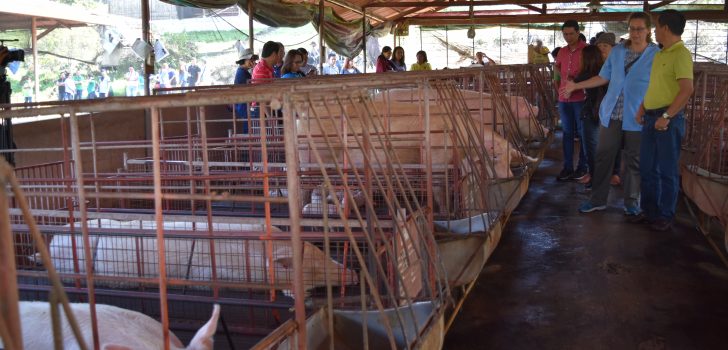 In these photos taken on Nov. 11, 2016, World Bank Task Team Leader Frauke Jungbluth is seen inspecting the site of the Negros Integrated Swine Enterprise on Rizal Street, Barangay Robles, La Castellana, Negros Occidental. The enterprise is the biggest in the Visayas Cluster. (John Paul Firmalino Cadiz, RPCO 6 InfoACE)
In these photos taken on Nov. 11, 2016, World Bank Task Team Leader Frauke Jungbluth is seen inspecting the site of the Negros Integrated Swine Enterprise on Rizal Street, Barangay Robles, La Castellana, Negros Occidental. The enterprise is the biggest in the Visayas Cluster. (John Paul Firmalino Cadiz, RPCO 6 InfoACE) Visayas cluster’s largest enterprise kicks off soon
Members of the La Castellana I Personnel Multi-Purpose Cooperative (LC I PMPC) heaved a sigh of relief after the World Bank gave the go signal for their P37.6-million-worth Negros Swine Integrated Enterprise subproject.
“The issuance of the No Objection Letter 1 (NOL 1) gave us a sense of assurance and relief that the [sub]project will be finally implemented. This will not only benefit us but also the cluster members,” said Judith B. Obordo, LC I PMPC chairperson. “We will try to comply with all the revisions and requirements needed based on the comments of the World Bank.”
At P37,698,241.30, the Negros Swine Integrated Enterprise is the largest subproject in the entire Visayas cluster under the Investments for Rural Enterprises and Agricultural and Fisheries Productivity (I-REAP) Component of the Department of Agriculture’s Philippine Rural Development Project.
Dr. Narissa Lemoncito of Negros Occidental’s Provincial Project Management and Implementation Unit said they began preparing all the documentary requirements since 2015. They have recently gotten the World Bank’s nod.
“The issuance of a conditional NOL is a blessing for all of us who participated in the preparation, review, and compliance of findings and recommendations. Receiving the NOL is dream come true. There was a lot of patience involved in this endeavor. We hope that this subproject will be implemented the soonest possible because it will benefit small hog raisers,” she said.
The Enterprise’s lead proponent is the LC I PMPC, and eight other associations complete the cluster. They are the following: La Castellana Hog Raisers Association (La Castellana), Victorias Integrated Livestock Raisers Association (Victorias City), Asosasyon ng Magbababoy sa Salvador Benedicto (Don Salvador Benedicto), Manapla Hog Raisers Association (Manapla), Binalbagan Hog Raisers Association (Binalbagan), Murcia Hog Raisers Association (Murcia), Talisay Backyard Hog Raisers Association (Talisay City), and Himamaylan Paravets and Hog Raisers Association (Himamaylan City). The total membership is at 1,008 farmer-beneficiaries.
The Enterprise has four components: feed manufacturing, production support through breeding and fattening, and marketing. The lead proponent, the LC I PMPC, will handle the breeding, feed production, and consolidation and marketing. The fattening aspect of the Enterprise will be handled by the cluster members, until the hogs reach the ideal weight. The LC I PMPC will then market the fattened hogs to the traders.
LC I PMPC has been in the swine breeding, fattening, and marketing business for many years. Its experience is not only limited to the production and management side, but it has also given the cooperative the opportunity to establish linkages with buyers within La Castellana and the neighboring towns. The cooperative operates its own feed mill.
Once the subproject goes full throttle following the NOL issuance, the objective is to increase farmer beneficiaries’ annual income by 281 percent from their present average income of P9,000 (for three fatteners) to approximately P27,960.38 per year (two modules of 10 piglets).
On the other hand, the Enterprise will also expand its feed mill operations by providing additional equipment and facilities that will increase the capacity from two tons to eight tons a day. The expansion of the feed mill operations can cater to the increasing number of hogs. The excess feeds of the fatteners will be sold to cluster members who are non-beneficiaries of the subproject.
VISAYAS CLUSTER’S BIGGEST ENTERPRISE
After learning of the NOL issuance, Obordo felt relieved that after two years, they can finally begin the procurement process. She said the cooperative had availed itself of loans from other institutions in the past, but their experience with the DA-PRDP was different from the previous ones.
“Our experience in [DA]-PRDP was very different in terms of the difficulty and meticulousness of all the requirements. We had a long time complying since we encountered a lot of technical difficulties along the way,” she said.
Obordo said the task was immense, but a team of specialists from the DA-PRDP’s Regional Project Coordination Office 6 (RPCO 6), Project Support Office Visayas Cluster and the National Project Coordination Office provided technical assistance every step of the way.
“They also adapted measures, like the geotagging, which enables the World Bank to see the actual location of the [sub]project and its beneficiaries. They observe social and environmental safeguards. The provincial government also supports us by providing the counterpart.”
She noted, however, that due to the thorough process, it takes a while before the DA-PRDP provides its evaluation and responds to the proponent group’s concerns. The compliance of SES also needs a lot of time to comply with, Obordo said.
“But I commend…and would recommend the PRDP’s process because you will be assured that the project directly benefits the proponent group, and the beneficiaries have social awareness to protect the environment. This also encourages the proponent group to grow their business for their sustainability,” she said.
With this partnership with the DA-PRDP, Obordo can see that LC I PMPC will be an “active and sustainable business enterprise that not only caters to the local market, but can also be competitive in the international market.
Meanwhile, May Ann B. Grajo, I-REAP component head of the Regional Project Coordination Office 6, said the total subproject cost may increase. This will depend on the revisions on the business plan, based on the World Bank’s comments. (John Paul Firmalino Cadiz, Writer, RPCO 6 InfoACE)


